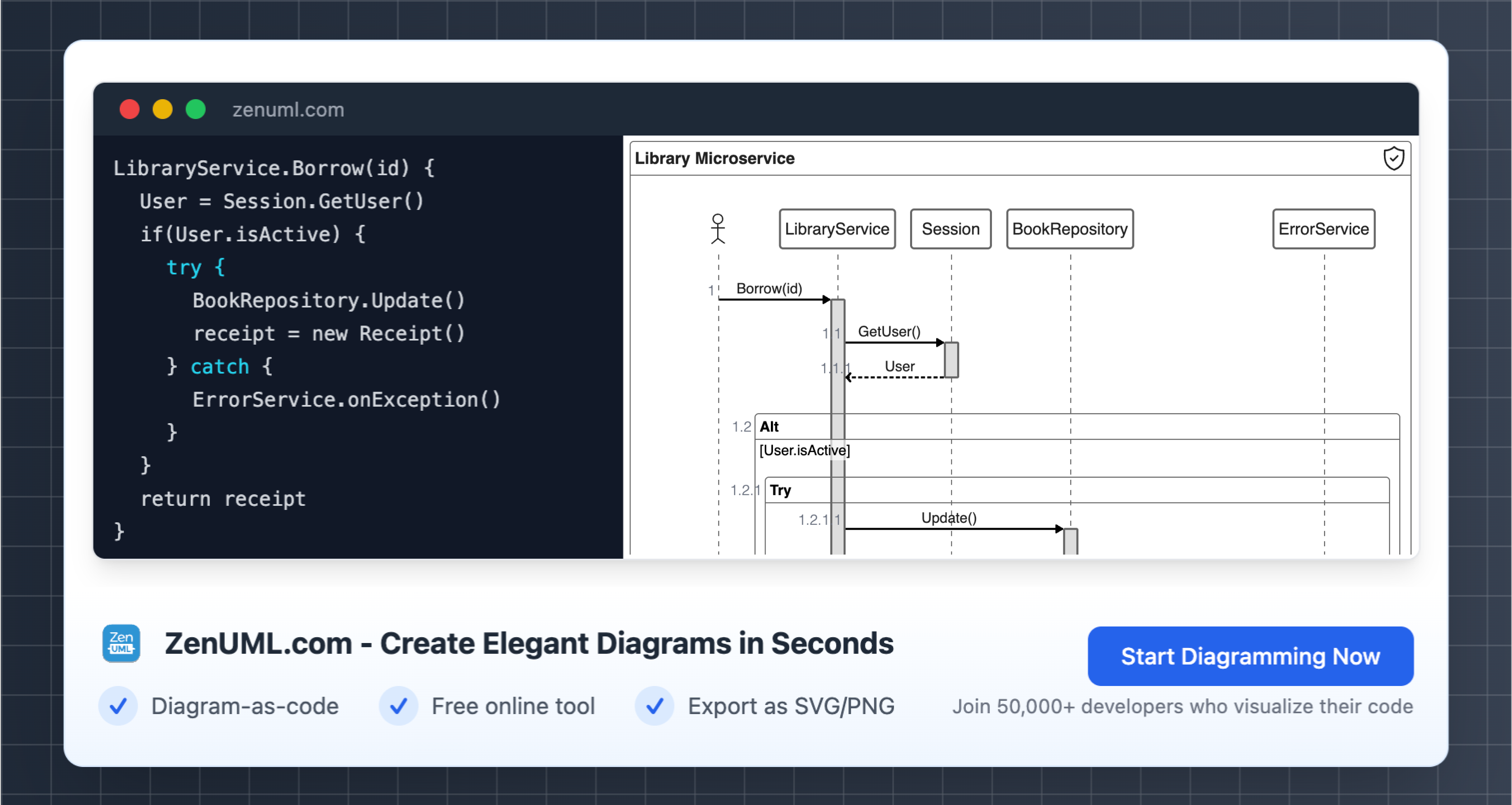
Introduction
In the fast-paced world of retail, efficient supply chain management is the key to staying competitive and meeting customer demands. One powerful tool that is often overlooked in this industry is the sequence diagram. Sequence diagrams provide a visual representation of the interactions between different entities within a system, allowing retailers to gain a deeper understanding of their supply chain processes and identify areas for improvement.
This blog post will explore how sequence diagrams can be applied to retail supply chain management, highlighting the benefits and showcasing real-world examples to inspire your own optimization efforts.
The Importance of Effective Retail Supply Chain Management
Effective supply chain management is crucial for the success of any retail business. According to a study by Deloitte, companies with optimized supply chains can achieve up to a 15% reduction in operational costs and a 30% increase in profitability.[^1] In the retail industry, where margins are often tight, these gains can make a significant difference in the bottom line.
Moreover, with the growing demand for faster delivery, personalized products, and seamless omnichannel experiences, retailers must have a well-oiled supply chain that can adapt to changing customer preferences and market conditions. Sequence diagrams can play a vital role in this process by providing a clear understanding of the interactions and dependencies within the supply chain.
Applying Sequence Diagrams to Retail Supply Chain Management
Sequence diagrams are a powerful tool for visualizing and analyzing the flow of information and materials in a retail supply chain. By representing the interactions between different entities, such as suppliers, warehouses, transportation providers, and retailers, these diagrams can help identify bottlenecks, optimize processes, and enhance overall efficiency.
1. Visualizing the Order-to-Cash Process
One of the key applications of sequence diagrams in retail supply chain management is the order-to-cash process. This process encompasses the entire journey from a customer placing an order to the retailer receiving payment. By creating a sequence diagram, retailers can gain a comprehensive understanding of the various steps involved, the stakeholders responsible, and the communication channels between them.
@Customer "Customer"
@Retailer "Retailer"
@Warehouse "Warehouse"
@ShippingProvider "Shipping Provider"
@PaymentProcessor "Payment Processor"
"Customer" -> "Retailer": Place Order
"Retailer" -> "Warehouse": Receive Order
"Warehouse" -> "Retailer": Confirm Inventory & Ship Order
"Retailer" -> "Shipping Provider": Arrange Delivery
"Shipping Provider" -> "Customer": Deliver Order
"Customer" -> "Payment Processor": Initiate Payment
"Payment Processor" -> "Retailer": Receive Payment
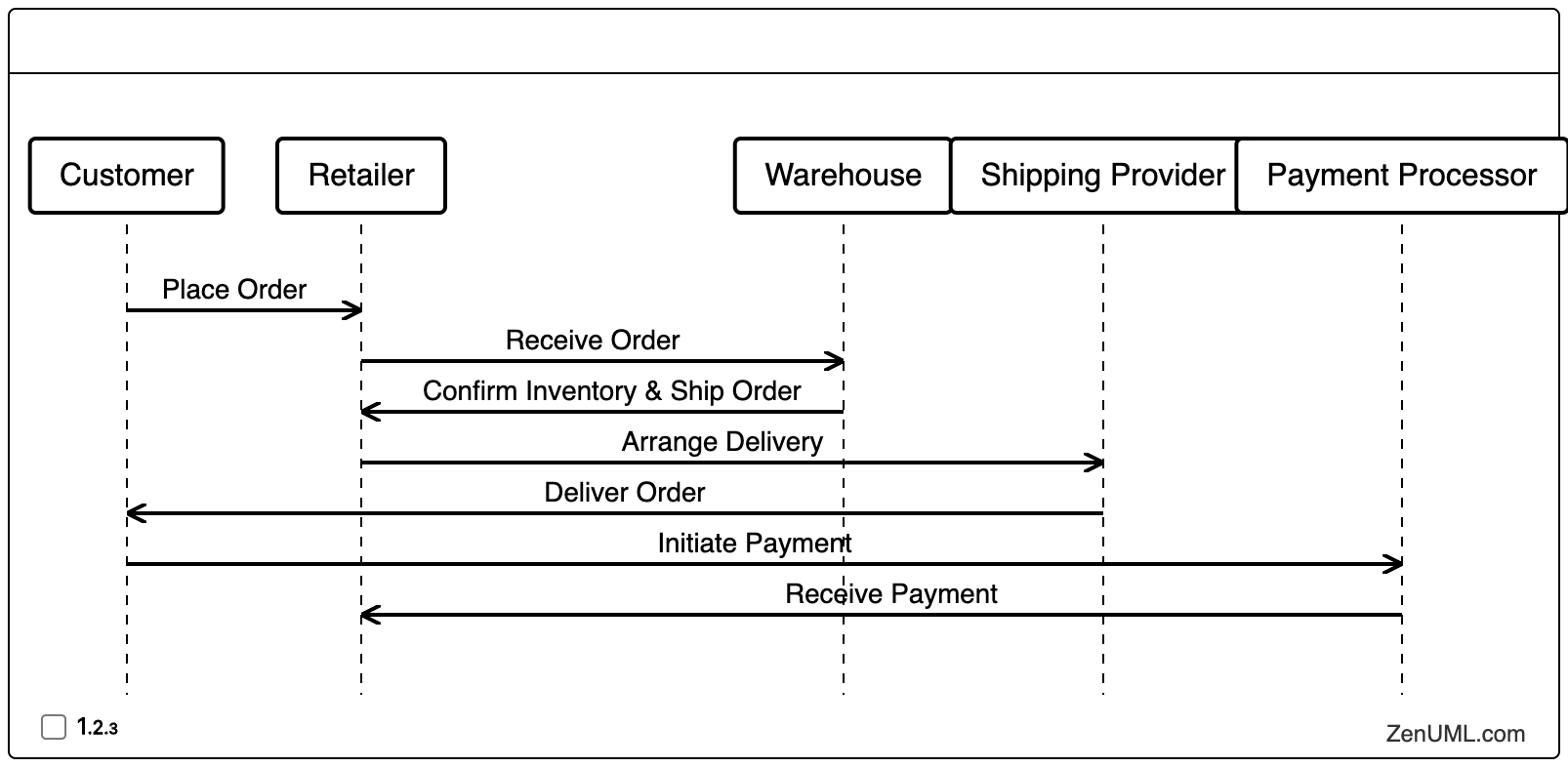
By analyzing this sequence diagram, retailers can identify potential bottlenecks, such as delays in order processing or issues with inventory management, and implement strategies to streamline the order-to-cash process.
2. Optimizing Inventory Management
Effective inventory management is crucial for ensuring that retailers have the right products in the right quantities at the right time. Sequence diagrams can help retailers visualize the flow of inventory throughout their supply chain, from procurement to distribution.
// Define participants
@Supplier "Supplier"
@Warehouse "Warehouse"
@Retailer "Retailer"
@Customer "Customer"
// Async Message from Supplier to Warehouse
"Supplier" -> "Warehouse": Deliver Inventory
// Async Message from Warehouse to Retailer
"Warehouse" -> "Retailer": Ship Inventory
// Async Message from Retailer to Customer
"Retailer" -> "Customer": Sell Inventory
// Async Message from Customer to Retailer
"Customer" -> "Retailer": Return Inventory
// Async Message from Retailer to Warehouse
"Retailer" -> "Warehouse": Receive Returned Inventory
// Async Message from Warehouse to Supplier
"Warehouse" -> "Supplier": Replenish Inventory
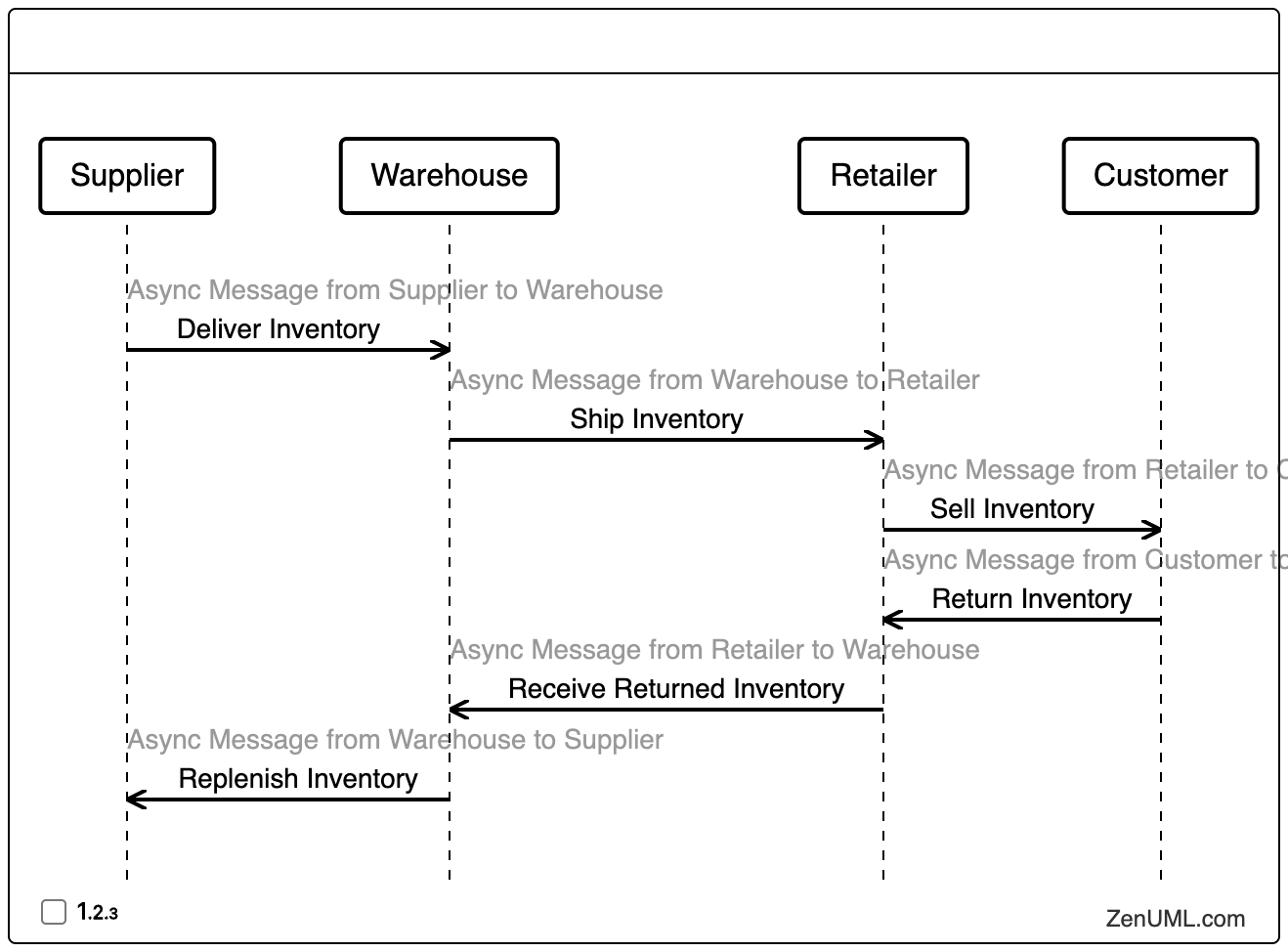
By analyzing this sequence diagram, retailers can identify opportunities to optimize inventory levels, reduce waste, and improve overall supply chain efficiency. For example, they can identify areas where inventory is building up or getting stuck, and implement strategies to streamline the flow of goods.
3. Enhancing Transportation and Logistics
Transportation and logistics are critical components of the retail supply chain, and sequence diagrams can help retailers optimize these processes. By visualizing the interactions between different transportation providers, warehouses, and retail locations, retailers can identify ways to reduce delivery times, minimize costs, and improve customer satisfaction.
// Define participants
@Participant "Supplier"
@Participant "Warehouse"
@Participant "Retailer"
@Participant "Shipping Provider"
// Async Message from Supplier to Shipping Provider
"Supplier" -> "Shipping Provider": Send Inventory
// Async Message from Shipping Provider to Warehouse
"Shipping Provider" -> "Warehouse": Deliver Inventory
// Async Message from Warehouse to Shipping Provider
"Warehouse" -> "Shipping Provider": Request Delivery
// Async Message from Shipping Provider to Retailer
"Shipping Provider" -> "Retailer": Deliver Inventory
// Async Message from Retailer to Shipping Provider
"Retailer" -> "Shipping Provider": Request Return Pickup
// Async Message from Shipping Provider to Warehouse
"Shipping Provider" -> "Warehouse": Deliver Returned Inventory
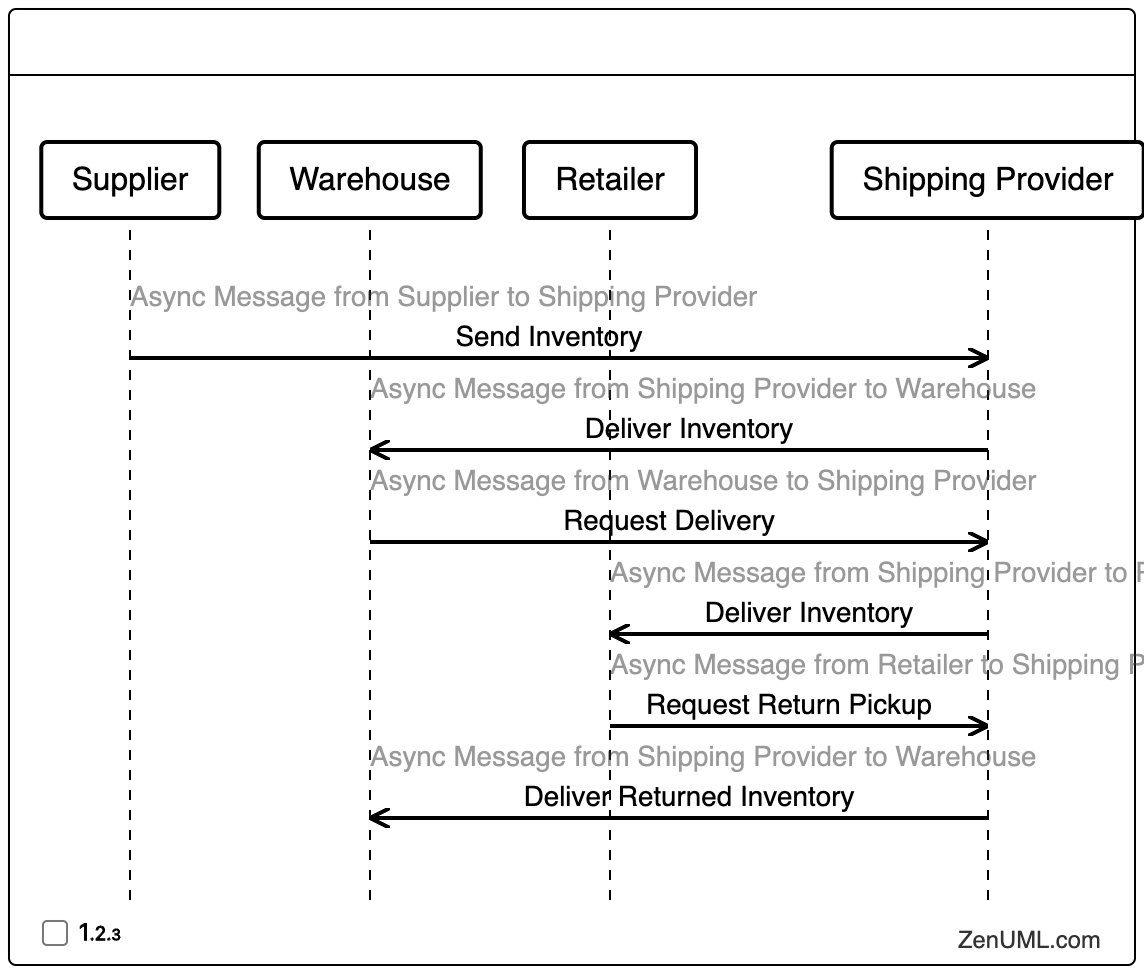
By analyzing this sequence diagram, retailers can identify opportunities to optimize transportation routes, streamline communication with shipping providers, and ensure that inventory is delivered to the right locations at the right time.
4. Facilitating Omnichannel Integration
In today's retail landscape, customers expect a seamless shopping experience across multiple channels, from in-store to online. Sequence diagrams can help retailers visualize the interactions between different systems and processes involved in their omnichannel operations, ensuring a smooth and consistent customer experience.
// Define participants
@Customer "Customer"
@RetailerWebsite "Retailer Website"
@RetailStore "Retail Store"
@Warehouse "Warehouse"
@ShippingProvider "Shipping Provider"
// Customer places an online order on Retailer Website
"Customer" -> "Retailer Website": Place Online Order
// Retailer Website sends the order to Warehouse
"Retailer Website" -> "Warehouse": Receive Order
// Warehouse ships the order to Shipping Provider
"Warehouse" -> "Shipping Provider": Ship Order
// Shipping Provider delivers the order to Customer
"Shipping Provider" -> "Customer": Deliver Order
// Customer returns the order to Retail Store
"Customer" -> "Retail Store": Return Order
// Retail Store sends the returned item to Warehouse
"Retail Store" -> "Warehouse": Receive Returned Item
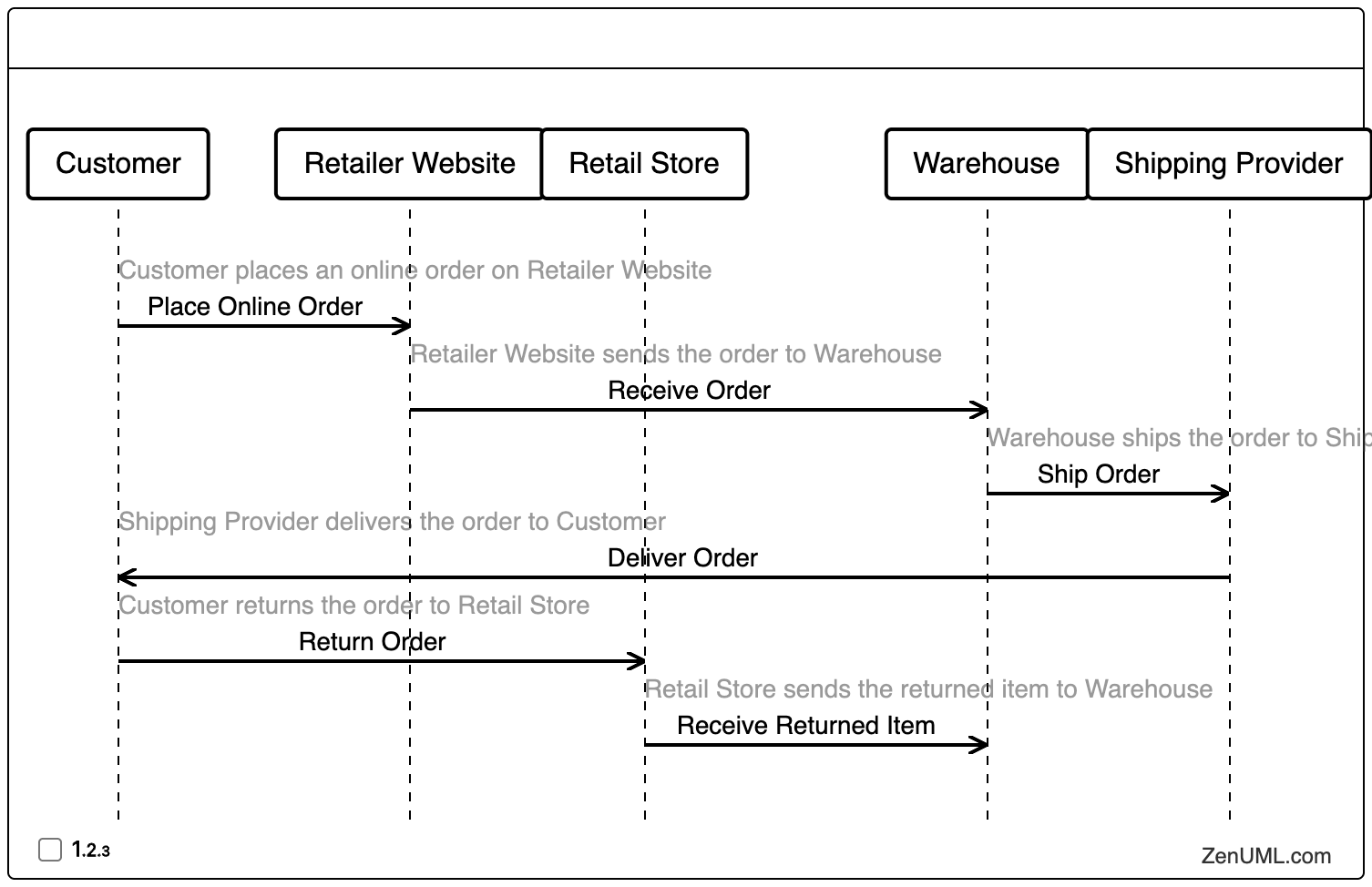
By analyzing this sequence diagram, retailers can identify areas where their omnichannel processes can be improved, such as synchronizing inventory data across channels, streamlining return and exchange processes, and ensuring seamless communication between online and offline operations.
The Benefits of Applying Sequence Diagrams to Retail Supply Chain Management
Adopting sequence diagrams in retail supply chain management can bring about a range of benefits, including:
-
Improved Visibility and Transparency: Sequence diagrams provide a clear and comprehensive visual representation of the supply chain, enabling retailers to identify bottlenecks, dependencies, and areas for improvement.
-
Enhanced Process Optimization: By understanding the interactions and flow of information and materials, retailers can make data-driven decisions to streamline processes, reduce costs, and improve overall efficiency.
-
Increased Agility and Responsiveness: Sequence diagrams can help retailers anticipate and adapt to changes in customer demand, market conditions, and supply chain disruptions, allowing them to remain competitive in a rapidly evolving landscape.
-
Effective Collaboration and Communication: Sequence diagrams serve as a common language that can be used to facilitate cross-functional collaboration and improve communication between different stakeholders within the supply chain.
-
Improved Customer Satisfaction: By optimizing their supply chain processes, retailers can deliver products and services more reliably, quickly, and efficiently, leading to enhanced customer satisfaction and loyalty.
According to a study by McKinsey, companies that effectively leverage supply chain analytics, which includes the use of tools like sequence diagrams, can achieve up to a 20% increase in supply chain efficiency.[^2]
Conclusion
Sequence diagrams are a powerful tool that can revolutionize retail supply chain management. By providing a clear and comprehensive visualization of the interactions and dependencies within the supply chain, retailers can identify areas for improvement, optimize processes, and enhance overall efficiency.
As the retail industry continues to evolve, the adoption of sequence diagrams will become increasingly crucial for retailers looking to stay ahead of the competition and meet the ever-changing demands of their customers. By embracing this powerful tool, retailers can unlock new levels of supply chain optimization and drive sustainable growth in the years to come.
We invite you to explore the world of sequence diagrams and how they can transform your retail supply chain management. Share your experiences, insights, and success stories in the comments below, and let's continue to revolutionize the retail industry together.
Try ZenUML now!
Zenuml detailed feature roadmap available here.

